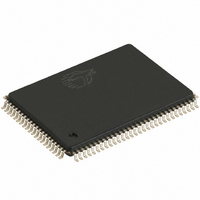CY7C1363C-133AXC Cypress Semiconductor Corp, CY7C1363C-133AXC Datasheet - Page 8

CY7C1363C-133AXC
Manufacturer Part Number
CY7C1363C-133AXC
Description
IC SRAM 9MBIT 133MHZ 100LQFP
Manufacturer
Cypress Semiconductor Corp
Datasheet
1.CY7C1361C-133AJXC.pdf
(34 pages)
Specifications of CY7C1363C-133AXC
Memory Size
9M (512K x 18)
Format - Memory
RAM
Memory Type
SRAM - Synchronous
Speed
133MHz
Interface
Parallel
Voltage - Supply
3.135 V ~ 3.6 V
Operating Temperature
0°C ~ 70°C
Package / Case
100-LQFP
Memory Configuration
512K X 18 / 256K X 36
Clock Frequency
133MHz
Access Time
6.5ns
Supply Voltage Range
3.135V To 3.6V
Memory Case Style
TQFP
No. Of Pins
100
Density
9Mb
Access Time (max)
6.5ns
Sync/async
Synchronous
Architecture
SDR
Clock Freq (max)
133MHz
Operating Supply Voltage (typ)
3.3V
Address Bus
19b
Package Type
TQFP
Operating Temp Range
0C to 70C
Number Of Ports
2
Supply Current
250mA
Operating Supply Voltage (min)
3.135V
Operating Supply Voltage (max)
3.6V
Operating Temperature Classification
Commercial
Mounting
Surface Mount
Pin Count
100
Word Size
18b
Number Of Words
512K
Rohs Compliant
Yes
Lead Free Status / RoHS Status
Lead free / RoHS Compliant
Lead Free Status / RoHS Status
Lead free / RoHS Compliant, Lead free / RoHS Compliant
Other names
428-2131
CY7C1363C-133AXC
CY7C1363C-133AXC
Available stocks
Company
Part Number
Manufacturer
Quantity
Price
Company:
Part Number:
CY7C1363C-133AXC
Manufacturer:
Cypress Semiconductor Corp
Quantity:
10 000
Company:
Part Number:
CY7C1363C-133AXCT
Manufacturer:
Cypress Semiconductor Corp
Quantity:
10 000
Pin Definitions
Document Number: 38-05541 Rev. *J
A
BW
BW
GW
CLK
CE
CE
CE
OE
ADV
ADSP
ADSC
BWE
ZZ
DQ
DQP
Note
3. CE
0
, A
1
2
3
s
A
C
[3]
,BW
X
,BW
1
Name
, A
3
is for A version of TQFP (3 Chip Enable Option) and 165 FBGA package only. 119 BGA is offered only in 2 Chip Enable.
B
D
asynchronous
asynchronous
synchronous
synchronous
synchronous
synchronous
synchronous
synchronous
synchronous
synchronous
synchronous
synchronous
synchronous
synchronous
Input-
Input-
Input-
Input-
Input-
Input-
Input-
Input-
Input-
Input-
Input-
Input-
Input-
clock
I/O-
I/O-
I/O
Address inputs used to select one of the address locations. Sampled at the rising
edge of the CLK if ADSP or ADSC is active LOW, and CE
active. A
Byte write select inputs, active LOW. Qualified with BWE to conduct byte writes to the
SRAM. Sampled on the rising edge of CLK.
Global write enable input, active LOW. When asserted LOW on the rising edge of CLK, a
global write is conducted (all bytes are written, regardless of the values on BW
Clock input. Used to capture all synchronous inputs to the device. Also used to increment
the burst counter when ADV is asserted LOW, during a burst operation.
Chip enable 1 input, active LOW. Sampled on the rising edge of CLK. Used in
conjunction with CE
HIGH. CE
Chip enable 2 input, active HIGH. Sampled on the rising edge of CLK. Used in
conjunction with CE
a new external address is loaded.
Chip enable 3 input, active LOW. Sampled on the rising edge of CLK. Used in
conjunction with CE
a new external address is loaded.
Output enable, asynchronous input, active LOW. Controls the direction of the I/O pins.
When LOW, the I/O pins behave as outputs. When deasserted HIGH, I/O pins are
tristated, and act as input data pins. OE is masked during the first clock of a read cycle when
emerging from a deselected state.
Advance input signal, sampled on the rising edge of CLK. When asserted, it
automatically increments the address in a burst cycle.
Address strobe from processor, sampled on the rising edge of CLK, active LOW.
When asserted LOW, addresses presented to the device are captured in the address
registers. A
asserted, only ADSP is recognized. ASDP is ignored when CE
Address strobe from controller, sampled on the rising edge of CLK, active LOW.
When asserted LOW, addresses presented to the device are captured in the address
registers. A
asserted, only ADSP is recognized.
Byte write enable input, active LOW. Sampled on the rising edge of CLK. This signal
must be asserted LOW to conduct a byte write.
ZZ “sleep” input, active HIGH. When asserted HIGH places the device in a
non-time-critical “sleep” condition with data integrity preserved. For normal operation, this
pin has to be LOW or left floating. ZZ pin has an internal pull down.
Bidirectional data I/O lines. As inputs, they feed into an on-chip data register that is
triggered by the rising edge of CLK. As outputs, they deliver the data contained in the
memory location specified by the addresses presented during the previous clock rise of
the read cycle. The direction of the pins is controlled by OE. When OE is asserted LOW,
the pins behave as outputs. When HIGH, DQ
condition.The outputs are automatically tristated during the data portion of a write
sequence, during the first clock when emerging from a deselected state, and when the
device is deselected, regardless of the state of OE.
Bidirectional data parity I/O lines. Functionally, these signals are identical to DQ
During write sequences, DQP
[1:0]
1
[1:0]
[1:0]
is sampled only when a new external address is loaded.
feed the 2-bit counter.
are also loaded into the burst counter. When ADSP and ADSC are both
are also loaded into the burst counter. When ADSP and ADSC are both
1
2
1
and CE
and CE
and CE
3
3
2
[3]
[3]
X
to select/deselect the device. CE
is controlled by BW
to select/deselect the device. CE
to select/deselect the device. ADSP is ignored if CE
Description
s
and DQP
X
CY7C1361C/CY7C1363C
correspondingly.
X
1
, CE
are placed in a tristate
2
1
, and CE
3
is deasserted HIGH.
2
is sampled only when
is sampled only when
3
[3]
are sampled
X
and BWE).
Page 8 of 34
s
.
1
is
[+] Feedback














